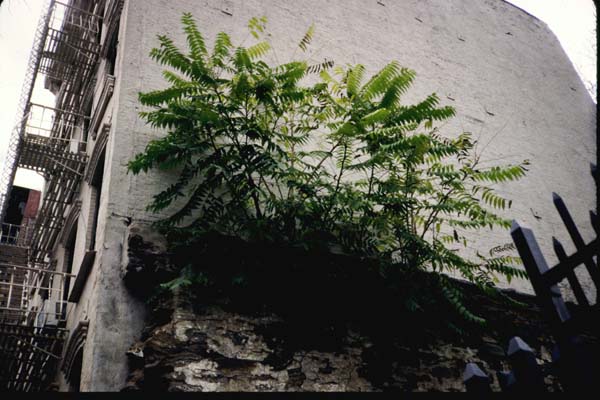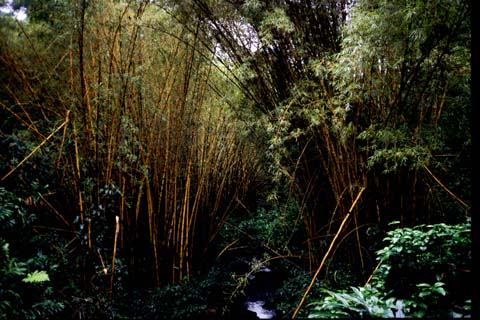Working for the past few days on my ‘Means of Production’ project, I found the first order of business was to cut the outrageously long grass with my kama. Shortly after starting I was approached by two Chinese women who were animatedly talking in Cantonese and pantomiming the kama’s cutting motion. I realized that they wanted to show me something. One lady spoke a little English and indicated to me that I was doing it incorrectly. She indicated that her 79 year old friend would show me how it is done. Apparently the 79 year old had spent her girlhood cutting grass for cooking fuel in the mountains of Guangdong Province and then went on to raise six children. What followed was a remarkable demonstration of ergonomic efficiency and she soon had a large area of grass cleared; the ‘swish swish’ of the kama punctuted by her cackling laughter and chortling expletives. The next day the pair gave a similar demonstation to the members of the Environmental Youth Alliance with whom I had been working, again laughing away as they showed us their mastery of a deceptively simple skill.
Later the MONOLITH arrived- a 5000 lb block of granite inscribed with the words “Means of Production”, a reference to Marx’s concept and our intention to furnish the raw materials needed for a degree of self sufficiency by planting an urban forest.

|
||||||
|
The dominant sensation I am dealing with these days is one of informational vertigo. As an avowed pattern sniffer, I am increasingly having trouble shutting out the data chatter and opening my mind to the big picture. But maybe that’s the point. On the one hand we have the epidemic phenomenon of constant partial attention. News floods in from the web, satellite TV, piles of newspapers, magazines etc. The phone rings constantly. Correspondence needs to be answered, bills need to be paid on-line. But how does one maintain balance? Filtration is the key, but already that is differentiating the continnuum. The ‘deep pattern’ is created through integration. The neural equivalent of the ‘smart mob’ organizational strategy, (which incidently is the one bright spot in the search for replacements for heirarchical organizational forms.) The constant chatter of cable network news contributes to what the venerable Walter Benjamin called ‘The State of Emergency’, which basically functions as a form of fascist social control. Pausing and reflecting have become a lost art and we are in fact encouraged not to do so because when we start to put together the many tiny sound bytes of our perceptions, we might not like what we see. Hence, my interest in deep time. In the nineteen eighties, I embarked upon a rather (arguably) Pyrrhic hobby of propagating slow growing desert plants from seed. Some of these have taken seemingly forever to reach any size, and need to be given long dormant periods, or they will turn into a rotten pulp. Throughout the wars, epidemics and climate change these little nubs of UWTB (see 5/22/2003 )inexorably add on infinitessmally small layers of growth, occasionally gracing us with an ephemeral flower. One of my favorites is the bizarre, Euphorbia obesa, a spherical little xerophyte from the baking shale rubble of the South African Karoo region. They are flowering now on my window sill, males and females on seperate baseball-shaped plants. In the absence of South African desert insects, they need to be hand pollinated with a little sable water-colour brush. I have managed to collect their sparse seeds and have propagated them into more little plants. Many of these plants are extremely endangered in the wild but have been saved from extermination because of the efforts of extreme ‘otaku’ horticulturalists. It’s something anyone with a window sill and an interest in ‘deep time’ can do. Species jumping is one of the scenarios being postulated for the spread of Mad Cow disease into Canada. Reuters points out that deer and elk, which commonly come into contact with cattle herds, are increasingly stricken by a disease similar to mad cow called chronic wasting disease spread though the proliferation of game farms. The existence of this disease in Alberta has led some to wonder whether it could have jumped to domestic cattle although scientists’ have failed in their own attempts to achieve that transmission. The BBC series Correspondent broadcast an amazing documentary called WAR SPIN (rebroadcast on CBC TV’s ‘The Passionate Eye), which reveals the orchestrated PR fakery behind the ‘rescue’ of Jessica Lynch. It turns out that the Iraqi doctors at the unguarded hospital to which Lynch had been brought had donated their own blood to Ms. Lynch and tried to bring her back to the US side, but the driver of the ambulance had been shot by American soldiers, nearly killing Lynch as well. As we hurtle towards the consumation of superpower hegemony and ‘total information awareness’, what continues to keep me going is what Kurt Vonnegut’s refers to in his 1959 (the year of my birth) (Sirens of Titan) as the principle of the ‘Universal Will to Become’ (UWTB). I spent the last day and a half hauling ass between Cortez Island and Saltspring Island to pick up a load of rare bamboos, which will form part of the basis of my self replicating art material supply system called ‘Means of Production’. I hung out with the local ‘bambuseros’ Doug Box and Naren Karter who supplied me with some botanical marvels. I just spent an interesting day at the “MEDIA THAT MATTERS” conference, listening to John Stauber of PR WATCH where I learned some interesting stuff. There are over 700,000 PR firms in the US constituting a 30-40 billion dollar a year industry There are more PR people than journalists in the US and the gap is widening. Over 40 % of what is called news, actually originates from the PR industry. I guess we are what we eat. May 3rd’s Globe and Mail ran a story about how vegetables from California are contaminated with a rocket fuel component which has leached into the irrigation water from weapons facilities. The contaminant, (perchlorate) was found in iceberg lettuces irrigated with water from the Colorado river, (see May 4th’s post re: this) Perchlorate impairs the ability of the thyroid to produce the hormones needed for proper fetal and infant brain development. There are concerns that high childhood exposure to perchlorate could lead to lower IQ scores, mental retardation and motor-skills deficits. So there it is. . . The military industrial complex is actually making us stupid. Somehow it doesn’t come as much of a surprise. From the my friends at Disinfopedia, comes this wonderful fieldguide to propaganda which should be required reading for anyone lost in the current morass of doublethink and doublespeak. Read it and weep. CNN ran a feature on the Eden Project which intends to restore the ancient marshes of Mesopotania that once extended from the juncture of the Tigris and Euphrates rivers in Iraq. All of a sudden this has become a ’cause celebre’ and one has to wonder why. While clearly of profound ecological importance, there seems to have been an unusual amount of attention being paid to this ecological restoration project by the US State department. After all, the marshes at the mouth of the Colorado river (quite ecologically analagous to the Tigris, Euphrates system) were almost completely destroyed by American damming and draining initiatives with similarly catastrophic ecological results such as the near extirpitation of the Yuma Clapper rail and the cultural life of the Cocopa Indians. Since the 1950s, the Tigris/Euphrates marshes have all but dried out due to upstream damming and draining initiatives both within and outside Iraq. This was exacerbated under Saddam Hussein’s regime because of the presence of the so called ‘Marsh Arabs’ which had been critical of his regime. The marshes were the purported site of the original ‘Garden of Eden’ and I can’t help thinking that America’s sudden focus on their restoration is an extension of the same Bush administration agenda of triumphalist, fundamentalist Christianianity that encouraged the looting of the Museum of Antiquities in Baghdad. History is being re-written as we speak and we’ll never know completely why. The image of the pelican regurgitating its dinner to feed its young has uncomfortable resonance to me with the way US media is uncritically regurgitating government agit prop to its population. |
||||||
|
Powered by WordPress · Atahualpa Theme by BytesForAll |
||||||







